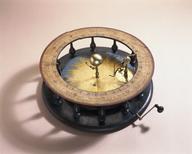

Leyden jar
- Made:
- 1750-1800




Leyden jar, maker unknown, 1750-1800.
Leyden jars were invented by Petrus van Musschenbroek in 1745. They are devices for storing static electricity and consist of two conductors separated by an insulator. This jar appears to be earlier than the other Leyden jars in the King George III collection of scientific instruments; the green glass is less perfect and the coating is lead foil. The jar is filled with iron filings.
Details
- Category:
- King George III
- Object Number:
- 1927-1273
- Materials:
- glass, lead, iron filings, sealing wax, brass and steel (metal)
- Measurements:
-
overall: 180 mm x 60 mm diamter, 0.77 kg
- type:
- leyden jar
- copyright:
- Unlinked Name
- credit:
- King's College, London




